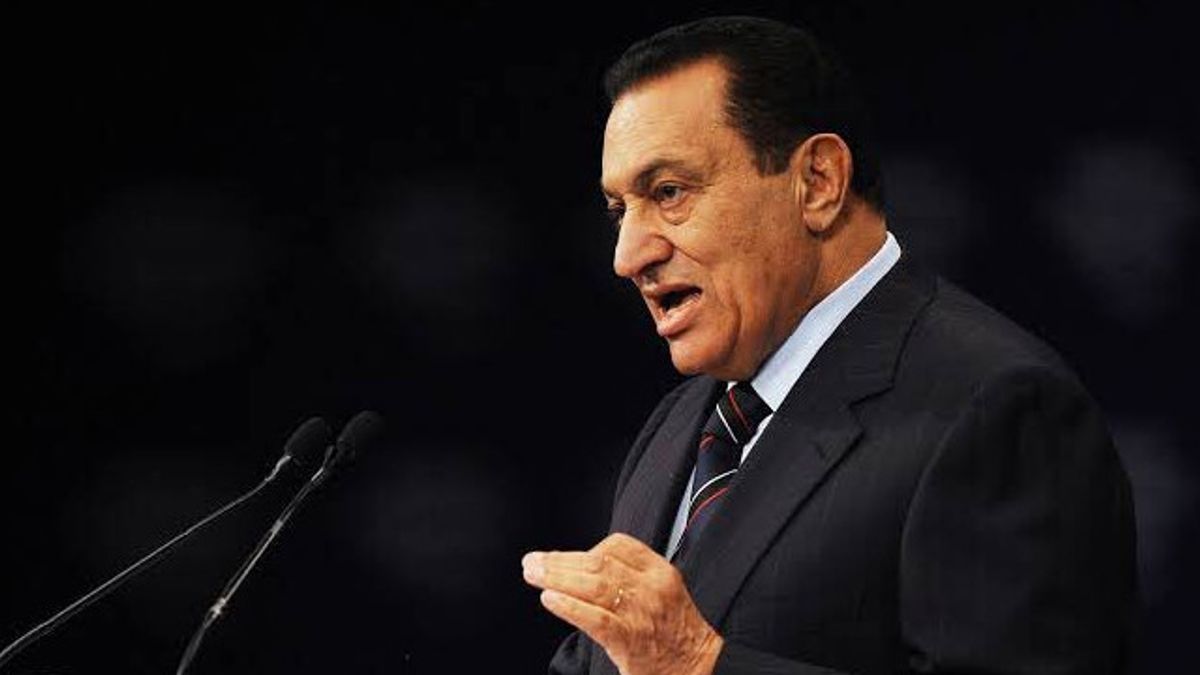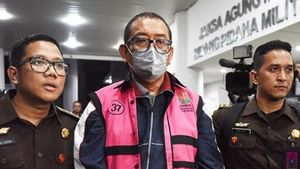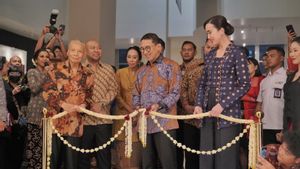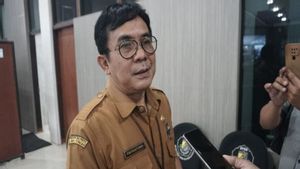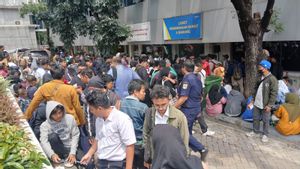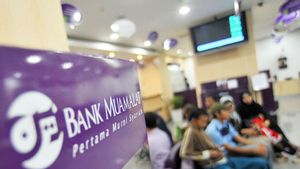JAKARTA - Former Egyptian President Hosni Mubarak, died on February 25. The president who ruled Egypt for 30 years died after receiving intensive care at a military hospital in Cairo.
The 91-year-old man is known as a hero, because of his role in the Arab-Israeli war in 1973. This momentum has made him sit in power in Egypt since 1981, until he finally stepped down in 2011 through the Arab Spring movement.
The passing of Hosni Mubarak gave a mixed impression. Ruled by Hosni Mubarak for 30 years, most Egyptians say they live under oppression.
Not to mention that many people find it difficult to find work and become unemployed. But on the other hand, Mubarak is also known as the patriot of Egypt, trying his best to make Egypt a strong and advanced country.
Egypt held a full-honors military funeral for its former autocratic President Hosni Mubarak, who was deposed after 2011's Arab Spring pic.twitter.com/7IklV8VMut
- QuickTake by Bloomberg (@QuickTake) February 26, 2020
Observing his background, Hosni Mubarak is a former high-ranking officer in the Egyptian Air Force with the rank of Air Marshal. This achievement attracted the attention of the then President of Egypt, Anwar Sadat. Where Mubarak was appointed as vice president.
Become a Hero and President of Egypt
The Arab-Israeli War in 1973 was the starting point for Hosni Mubarak in the eyes of the Egyptian people. The war was between Arab allies of Egypt and Syria against Israel over disputed territory claimed by Israel in the 1967 Six-Day War.
Hosni Mubarak was the figure behind the airstrikes, which lasted twenty minutes and managed to destroy 90 percent of Israel's fortifications. Through this success, Mubarak managed to restore Egyptian confidence.
As the best embodiment of the Egyptian military, Hosni Mubarak served as the spokesman for every Arab country during the 1970s. On April 15, 1975, President Anwar Sadat appointed Mubarak as vice president.
Hosni Mubarak quickly established himself as a skilled negotiator, leading several diplomatic missions to Arab countries, Europe and, most importantly, Israel. As Sadat became increasingly interested in negotiating privately with Israel in the late 1970s, Mubarak began to assume greater control over Egypt's internal affairs.
On behalf of the citizens and Government of Israel, I would like to express deep sorrow on the passing of President Hosni Mubarak. President Mubarak, my personal friend, was a leader who led his people to peace and security, to peace with Israel. pic.twitter.com/J6FfCp9iPG
- PM of Israel (@IsraeliPM) February 25, 2020
Strongly confident in Hosni Mubarak's abilities, President Sadat allowed Mubarak to run weekly cabinet meetings as well as the country's intelligence agency, oversee the development of Egypt's nuclear energy program, and to perform other duties from the president's office. Hosni Mubarak is also deputy chairman of the National Democratic Party (NDP), Egypt's largest and most powerful political party.
On October 6, 1981, Mubarak stood beside President Sadat in celebration of Egypt's success in the Arab-Israeli War. As a military plane shot across the sky overhead, a group of armed men jumped from a truck parked in front of the presidential watchdog seat. One threw a grenade and the other three exploded their weapons. The attackers were Islamic fundamentalists, who wanted to overthrow Egypt's secular government.
Hours after the attack, Mubarak announced the death of President Sadat, which saw him automatically become president. On 7 October 1981, the NDP selected Hosni Mubarak as its presidential candidate and won 98 percent of the vote and officially began his first six-year term as president of Egypt. After that he often won elections and was the longest running leader in Egypt from 1850 to the 2005 Egyptian elections.
Egypt was in difficult times when Hosni Mubarak took the chair. The Egyptian economy is in bad shape and unemployment is high. Egypt's population continues to grow every year. Hosni Mubarak finally focused on improving the economy by building infrastructure. Hosni Mubarak tries to attract foreign countries to invest in Egypt. He also encourages the use of contraception to regulate the population.
Prior to Hosni Mubarak's leadership, many state-owned companies were sold to private investors, but many of these transactions became easy targets for corruption, leaving very few people very rich. As a symbol of his efforts to bridge the gap between rich and poor, Hosni Mubarak ordered the destruction of several of the luxury retreats that Sadat had built.
Under Hosni Mubarak's rule, Egypt became the second largest recipient of US aid, after Israel. With this assistance, Egypt repaired roads, built schools, offered assistance to farmers and developed other social programs.
Overthrow of Hosni Mubarak
Hosni Mubarak won the presidential election many times, many times he also said that he had never found someone who deserved to replace him. Hosni Mubarak felt that only he could control the country where the Spinx statue was. This made him an authoritarian leader.
“Nobody imagined we could push a button and freedom would come. Otherwise, it will bring the country to chaos and it will be a danger for the people, ”said Hosni Mubarak.
However, the 2005 election was his final victory. In 2011, Arab countries such as Libya, Yemen and Tunisia were experiencing turmoil demanding regime change. This upheaval is also known as the Arab Spring Revolution. The impact is very significant because it succeeded in overthrowing leaders and establishing elections in a democratic manner.
"[Hosni Mubarak] oversaw a lot of injustice in this country. It was a great injustice." As a state funeral is held, Egyptians share their thoughts on former President Hosni Mubarak. pic.twitter.com/Z7rrWqftrb
- Al Jazeera English (@AJEnglish) February 26, 2020
Quoted from Britannica, Egypt became one of the countries that carried out the Arab Spring Revolution. Demonstrations organized by youth groups, mostly from opposition parties, took place in the capital and in cities across the country.
Protesters are calling for Hosni Mubarak to step down, paving the way for free elections and democracy. As the demonstrations intensified, Mubarak's regime adopted increasingly violent tactics that resulted in hundreds of people being injured and killed.
Hosni Mubarak's attempts to placate the protesters by promising to resign at the end of his term in 2011 and calling Omar Suleiman his deputy had little success in quelling the unrest. After nearly three weeks of mass protests in Egypt, in February 2011 Hosni Mubarak finally officially resigned and the Egyptian military took control of the country.
After being successfully overthrown, Hosni Mubarak was languishing in prison on various charges. He is accused of conspiring to kill protesters which resulted in a life sentence in 2012.
Allegations of corruption were also made but were canceled in January 2015. Reporting from The Guardian, in 2017 Hosni Mubarak was acquitted and freed from the accusations so far. During the trial, Hosni Mubarak did not look healthy, he often had to be stretched and wore black glasses. After leaving prison, his health continued to decline until February 25, 2020, Hosni Mubarak died.
The English, Chinese, Japanese, Arabic, and French versions are automatically generated by the AI. So there may still be inaccuracies in translating, please always see Indonesian as our main language. (system supported by DigitalSiber.id)
